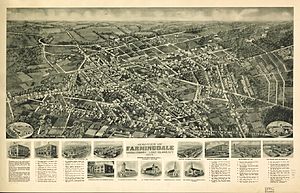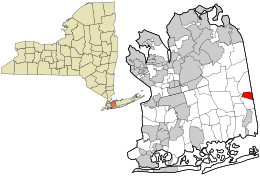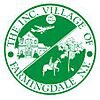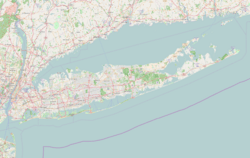Farmingdale, New York facts for kids
Quick facts for kids
Farmingdale, New York
|
|||
|---|---|---|---|
| Incorporated Village of Farmingdale | |||

Panoramic map of Farmingdale from 1925, with a list of landmarks and several images in the insets at the bottom
|
|||
|
|||
| Nickname(s):
"Farmingdale Village", "The Village"
|
|||

Location in Nassau County and the state of New York
|
|||
| Country | |||
| State | |||
| County | Nassau | ||
| Town | Oyster Bay | ||
| Incorporated | 1904 | ||
| Area | |||
| • Total | 1.09 sq mi (2.83 km2) | ||
| • Land | 1.09 sq mi (2.83 km2) | ||
| • Water | 0.00 sq mi (0.00 km2) | ||
| Elevation | 69 ft (21 m) | ||
| Population
(2020)
|
|||
| • Total | 8,466 | ||
| • Density | 7,738.57/sq mi (2,987.43/km2) | ||
| Time zone | UTC−5 (Eastern (EST)) | ||
| • Summer (DST) | UTC−4 (EDT) | ||
| ZIP Code |
11735
|
||
| Area codes | 516, 363 | ||
| FIPS code | 36-25384 | ||
| GNIS feature ID | 0949918 | ||
Farmingdale is a village located on Long Island in New York. It is part of the Town of Oyster Bay in Nassau County, New York. In 2020, about 8,466 people lived here.
The village is close to Bethpage State Park. You can drive there in about fifteen minutes. Farmingdale is also about 37 miles (59 km) southeast of Midtown Manhattan in New York City. You can reach it by train using the Long Island Rail Road. Major highways like the Long Island Expressway also connect Farmingdale to other areas.
Contents
History of Farmingdale
Early Settlers and Land Deals
The first European to settle in this area was Thomas Powell. He arrived in 1687. In 1695, he bought a large piece of land, about 15 square miles (39 km2), from three Native American tribes. This land deal is known as the Bethpage Purchase. It included not only Farmingdale but also other nearby places like Bethpage and Plainview. One of the houses Thomas Powell built around 1738 is still standing in Farmingdale today.
The Railroad Arrives
In the 1830s, a land developer named Ambrose George bought a big piece of land. He knew the Long Island Rail Road (LIRR) was going to build tracks nearby. He built a general store on his land and called it Farmingdale. When the LIRR started its service in October 1841, it named its new stop Farmingdale. This made it easier for people to travel. Stagecoaches would take people from the Farmingdale station to other towns like Islip and Babylon.
Becoming an Official Village
As more people moved to Farmingdale, the community grew. In 1886, a fire department was started to help keep everyone safe. Then, in 1904, Farmingdale officially became an incorporated village. This meant it could have its own local government.
Growth and New Industries
In 1923, the Lenox Hills Country Club was built north of the village. It was an 18-hole golf course. Later, the State of New York bought this golf course and made it much bigger. It reopened in 1932 as Bethpage State Park, which is now famous for its golf courses. Farmingdale also became important for the aircraft industry, especially with the Republic Aviation Company building planes here.
A fun fact from 1899: a cyclist named Mile-a-Minute Murphy rode his bicycle through the Farmingdale area at an amazing speed of a mile a minute! For many years, the town celebrated its history with an event called the Hardscrabble Fair. It had music, food, and games.
What "Farmingdale" Means
The name "Farmingdale" is used for more than just the village itself. It also refers to nearby areas that are not officially part of the village. For example, South Farmingdale and East Farmingdale use "Farmingdale" in their mailing addresses. Even Bethpage State Park, which is mostly in another town, has a "Farmingdale" mailing address. This can sometimes be a bit confusing!
Where is Farmingdale?
Farmingdale is a small village. It covers about 1.1 square miles (2.8 km2) of land. The village has grown a little over the years.
Weather in Farmingdale
Farmingdale has a humid subtropical climate. This means it has hot, humid summers and mild winters. The hottest temperature ever recorded in Farmingdale was 102°F (39°C) in July. The coldest temperature recorded was -1°F (-18°C) in January.
Who Lives in Farmingdale?
The number of people living in Farmingdale has changed over time. In 1880, there were 524 people. By 2020, the population had grown to 8,466 people.
In 2010, most people in Farmingdale were White (about 88.2%). About 2.6% were African American, and 2.5% were Asian. About 13.7% of the population was Hispanic or Latino.
Getting Around Farmingdale
Farmingdale has several ways to get around.
- Air Travel: Republic Airport is nearby. It's used for smaller planes and helps with air traffic around New York City.
- Buses: The NICE bus system has routes n70 and n71 that serve Farmingdale.
- Trains: The Long Island Rail Road has a station in Farmingdale. This station is a central point for the village.
- Roads: Major roads include New York State Routes 24, 27, 109, and 110. The Southern State Parkway and Bethpage State Parkway also pass through or near the area.
There are plans for a Long Island Greenway to connect Farmingdale all the way to Montauk. This would be a great path for walking and biking.
Famous People from Farmingdale
Many interesting people have connections to Farmingdale.
- Gregory W. Carman (1937–2020) was a US Congressman.
- Peter J. Ganci Jr. (1946–2001) was the Chief of Department for the FDNY. He sadly passed away during the September 11 terrorist attacks.
- George Hincapie is a professional bicycle racer.
- Ed Kranepool was a baseball player who lived in South Farmingdale for many years.
- SallyAnn Salsano is a TV producer known for reality shows like Jersey Shore.
- Al Weis was also a baseball player.
See also
 In Spanish: Farmingdale (Nueva York) para niños
In Spanish: Farmingdale (Nueva York) para niños





